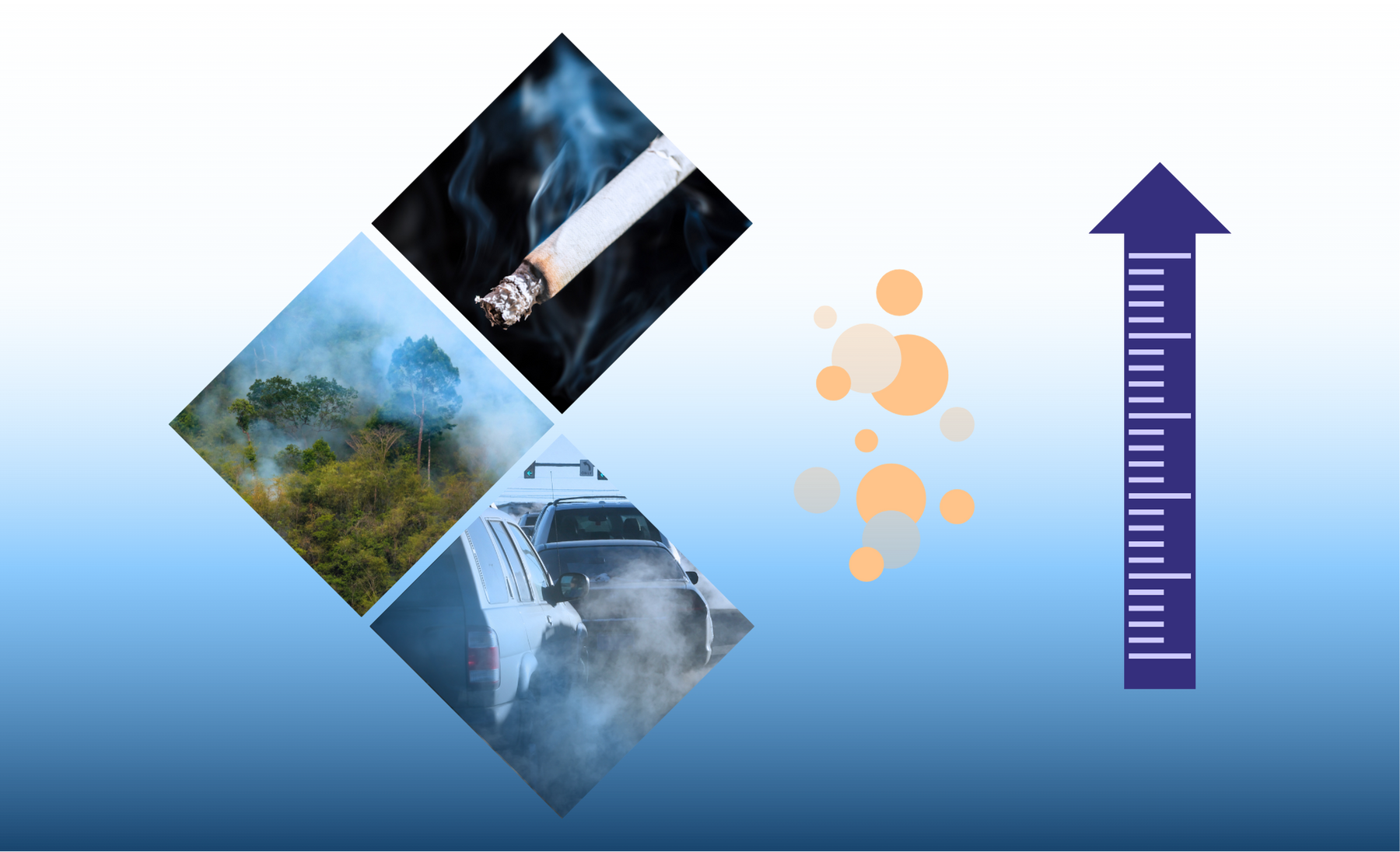We’ve all seen the wildfires rage through parts of the western U.S. and Canada in recent years. The smoke from these fires has significantly worsened indoor air quality in that region. In a time when climate change is increasing the frequency and intensity of wildfires, the functionality of indoor air filters is incredibly important.
We’ve been using conventional air filters for decades in HVAC (Heating, Ventilation, and Air Conditioning) systems to heat, ventilate, and cool our indoor spaces. These filters remove particulate matter and various air pollutants that can be harmful to our lungs. But are these conventional air filters prepared to handle and remove the particulate matter created by wildfires? That’s what we’re here to talk about today.
Challenges of Filtering Wildfire Smoke
How Do Air Filters Work?
Traditionally, air filters act like a very fine strainer, stopping dust, pollen, and other pollutants from passing through. The finer the filter, the smaller particles can be trapped. However, this comes with a trade-off: a very fine strainer will cause a restriction in airflow. If such a fine filter is installed into the air purification system or HVAC, the pressure drop will increase the energy consumption of the system.
The ideal indoor air filter would be a type of “mesh or strainer” with high efficiency AND low back pressure. This can be achieved by introducing a charge onto a filter’s fiber. Polymer electret filters carry an electric charge and are very popular in HVAC systems. They provide notable initial efficiency and a low-pressure drop. However, the drawback is the rapid decay of their charges in the presence of smoke.
The Impact of Wildfire Smoke on Filters
Wildfire smoke particles can be transported large distances from wildfire locations and easily penetrate our homes. It has a very complex composition, being made up of hundreds of volatile organic compounds and chemicals plus large amounts of particulate matter 2.5 (PM2.5). Multiple studies show that most of these particles are in the submicron range, and contain many organic, carbon-based compounds. This results in very different interactions between these types of particles and filter fibers.
A recent study by scientists at Metalmark Innovations tested several air filters with pine needle smoke, to simulate the wildfire submicron particles of the real world. The researchers used particle counters and scanning electron microscopy (SEM) to understand how the air filters and smoke particles interacted with one another.
Gaps in Measuring Efficiency & Current Air Filters Testing Standards
Testing and rating air filters in the US is normally done based on ASHRAE standards. Filter media and filters are assigned a value based on the MERV system (Minimum Efficiency Reporting Value) on a scale from 1 to 20, with higher numbers meaning better filtration efficiency. To assign a grade or rating, test filters are typically challenged with inorganic salt particles of various sizes based on the standard test protocols. The filter’s ability to trap these particles determines its rating.
What’s in most residential and commercial HVAC systems is largely MERV 8 filters. During COVID-19, public health recommendations advocated for MERV 13. And, it’s generally accepted that the same grade would be highly effective for smoke removal.
The researchers behind the study came to an important realization: the standards used for testing filter efficiency need to be more comprehensive when it comes to wildfire smoke. Most filters are tested based on inorganic salt particles in the range of 0.3-10 μm. There are two problems with this type of measurement.
First, the size of smoke PM is usually below 0.3 μm (typically 100-200 nm). Second, the chemical composition of smoke particulates is very different from inorganic salts. They contain large amounts of chemicals (organic compounds). As it turns out, this matters to the filtration efficiency outcomes of filter media. The trends observed with the pine needle smoke particles in this study were different from established patterns seen with inorganic particles.
This challenges the conventional expectations of measuring an air filter’s effectiveness, and it suggests that existing rating systems for filters aren’t capturing important data on wildfire smoke filtration capabilities.
Challenges in Measuring Wildfire Smoke
Another issue with understanding wildfire smoke is that current PM measurements focus on PM2.5 sensor values reported in mass concentration. Small particles below 300 nm contribute very little to the total mass, even at very high concentrations.
For example, the mass concentration of 10 μg/m3 (considered healthy air) of 2 μm diameter particles contains about 1.6 particles per mL of air. In contrast, the same mass concentration of 100 nm particles contains ~12,740 particulates. And during a “smoky” day, we can have billions of tiny toxic particles in just 1 mL of air!
Because wildfire smoke is becoming a more prevalent threat to human health, accurately understanding and measuring smoke particles and applying the knowledge toward rating an air filter is of incredible importance.
Learnings About Filter Media
Take a look at the SEM image below.
SEM image of pine needle smoke accumulation on fiber media, forming “pearl strands”.
The Metalmark study indicates that for common HVAC filters, made with electret media, smoke “deactivates” their charges. All that was left after testing was a “coarse mesh strainer.”
So, Which Filter Media Worked Best?
- MERV ratings of filters do not translate for smoke well.
- Not surprisingly, high MERV 15-16 microglass, a high-quality material used for high MERV, HEPA, and ULPA filtration, worked best.
- Microglass media were the most efficient at removing wildfire smoke from the air. However, these filters slow down the airflow and increase energy use in HVAC systems.
- The efficiency of electret filters for salts dropped significantly when exposed to smoke or aging (as much as 95% less effective). However, this behavior is drastically different from testing with smoke. In general, electret media maintained lower than expected efficiency against smoke than their MERV ratings suggest.
Recommendation
Metalmark is actively addressing the pressing issue of indoor air quality compromised by escalating wildfires. To do this, the team is engaging in further research and technological advancement to improve air filtration systems.
The Tatama air cleaner by Metalmark stands out as a solution to wildfire smoke pollution in the Western United States. Made with HEPA-grade filters, these air cleaners were specifically designed to capture an array of pollutants that include the small size and organic compounds of wildfire smoke.
The self-renewing system periodically removes accumulated pollutants caught in the filter to extend the filter lifetime upwards of 5 years. The Metalmark’s technology was named winner of the US EPA’s Cleaner Indoor Air during Wildfires Challenge.
A Path Forward for Wildfire Smoke Filtration
The air we breathe inside our homes, schools, and offices is crucial to our health, and we need top-notch indoor air quality (IAQ) solutions to tackle the challenges posed by these increasingly intense fires.
It’s not just about keeping the air clean though– we’re talking about a holistic approach. We want solutions that not only prioritize our health, but also align with climate resilience, energy efficiency, and green building standards.
All of this is to say that we need IAQ solutions that go beyond the basics. With more wildfires on the horizon, the amount of particulate matter floating around will likely get worse. Smart air filter choices and continued research will make our indoor spaces healthier while contributing to the bigger picture of a sustainable and resilient future.

Tatama Air Cleaner
For commercial new construction or retrofits into existing facilities
Tatama uses Metalmark’s advanced HEPA-grade filters to capture airborne particulates, smoke, VOCs, and pathogens, including viruses and bacteria.

Sierra Air Filters
For your existing commercial HVAC systems
The HVAC filter with enhanced protection against wildfire smoke. A simple drop-in replacement with no change to air flow or pressure.



